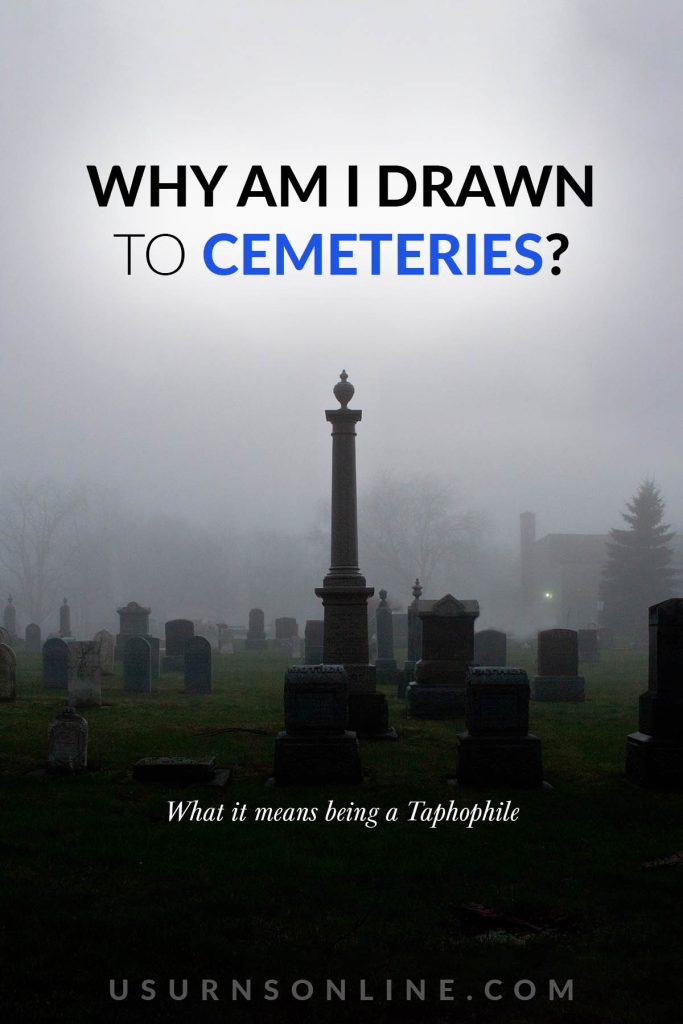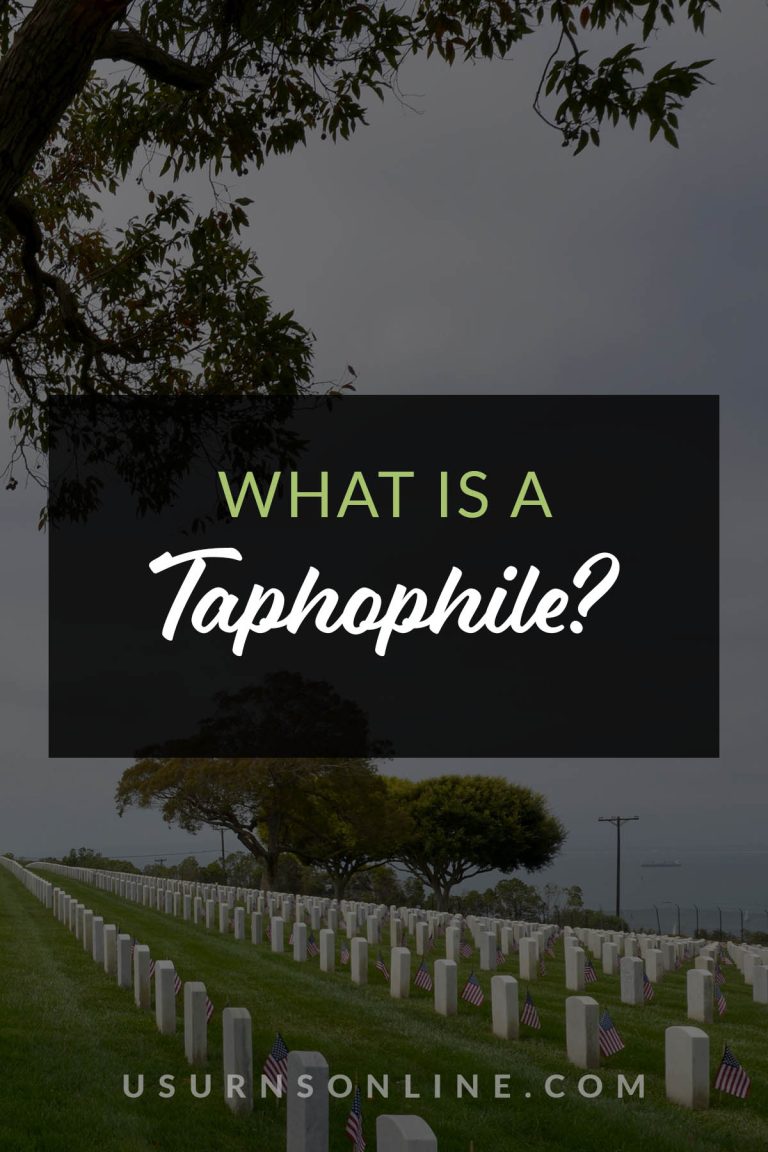Taphophilia. It sounds weird, like some sort of condition. (Maybe it is….)
What is a taphophile? Similarly, what is coimetromania? And why are some people drawn to cemeteries?
Let’s find out.
Taphophilia Meaning
Taphophilia is a love of funerals, cemeteries, and the rituals of death.
Some people like to take photographs, do a rubbing, or even draw the tombstones they are visiting. As long as the sexton or cemetery personnel don’t mind, it is ok to do it.
Taphophile Meaning
Similarly, a taphophile is someone who loves funeral, cemeteries, and has an interest in death rituals. Also known as a tombstone tourist, cemetery enthusiast, grave hunter, or simply a “graver.”
The taphophile is a person with a passion for graveyards, epitaphs, and gravestone rubbing. They are also often attracted to photography, art, and the history of (famous) deaths.
Taphophilia vs Coimetromania
The coimetromania definition is an abnormal attraction and desire to visit cemeteries, graveyards, and anything to do with the dead.
Psychologists consider coimetromania a mental condition. As with any mania, this condition can cause people to experience unreasonable and intense feelings.
As an interest or hobby, taphophilia is accepted by normal society. Although some might consider it a strange and somewhat unusual hobby, it’s no different than an interest in WWII battles, superhero cosplay, or collecting teacups.
Urns Made in the USA
Coimetromania is different. This condition could feature obsessive behavior alongside dramatic emotional highs and lows.
Why Am I Drawn to Cemeteries?
You’re not alone in your fascination with cemeteries. It is more common than you may think.
The question is why are you, me, and thousands of others attracted to cemeteries? Here are six possible reasons.
1. You need some alone time.
A cemetery is one place you can go by yourself. No phones, no pets, no kids, or other distractions.
This is a simple approach to the age-old problem of alone time. You can enjoy being outdoors, seeing beautiful greenery and flowers, along with some solitude and quiet.
2. You are visiting a loved one.
Paying respects to a loved one is one of the main reasons people visit cemeteries.
Going to visit Grandma’s grave with fresh flowers is respectful. It gives us comfort to remember our loved ones.
Related: How to Decorate a Grave
3. You are feeling whimsical, moody, prayerful, peaceful….
Each and every cemetery, from the clean modern ones to the worn-down and overgrown ones, can stir up powerful emotions.
There’s nothing like being in an ancient graveyard on a windy October day, with leaves falling and crunching beneath your footsteps. And there’s nothing like walking through the perfectly manicured pathways of a hilltop cemetery, smelling the flowers and feeling the sun shining down, which makes the luscious green grass even more bright.
It’s the perfect place to think, journal, meditate, observe the beauty of creation, pray, and reflect on life and death.
Related: What does it mean when people leave coins on graves?
4. Cemeteries are rich in history and culture.
Don’t believe me? Visit a cemetery. Find the oldest section and read the epitaphs. Some of them are very “telling” about the decedent.
Some epitaphs are simple: Here lies George Smith. Nothing else is noted—no dates or pertinent information.
Some are comical, if not a little off-color. Take Russell Larsen’s, for example: Two things I love most. Good horses and beautiful women. And when I die, I hope they tan this old hide of mine and make it into a ladies riding saddle, so I can rest in peace between the two things I love the most.
Mary Dolencie’s epitaph has anger in it. May eternal damnation be upon those in Whaling Port, who without knowing me have maliciously vilified me. May the curse of God be upon them and theirs.
If you would like to read some more funny and interesting epitaphs, see here.
By reading the dates on the headstones, you can tell when an epidemic hit the community. (This resonates more now, don’t you think?) You will see when children were hit by sickness.
Epidemics have been around for as long as the world has been turning. The first recorded epidemic was in Babylon around 1200 BC.
Read the list below to see what some of the United States epidemics have been. (And the ones you can easily find in a cemetery.)
- Smallpox
- Typhoid fever
- Diphtheria epidemic
- Spanish flu
- Yellow fever
- Polio epidemic
- Measles epidemic
- Influenza epidemic
This is just a short list, but you get the idea. Walking around a cemetery, you can see by the dates how many people died due to epidemics of the time.
You may also run across some interesting and memorable quotes on the tombstones.
5. You have an interest in spirituality and the afterlife.
Most people believe in some sort of life after death. Not only does the afterlife feature prominently in most religions, but many people also believe in ghostly apparitions and communication with the dead. About 50% of people believe in ghosts and 20% believe we can communicate with ghosts.
Cemeteries have always been a prime location to attune our thoughts to the realities of life and death. Many people feel a closer connection to God, to their departed loved ones, or to the spirits of the dead when visiting a cemetery.
6. You are an architecture buff.
Cemeteries often have amazing and beautiful architecture. Take a look at the mausoleums, the grand arches, and the graceful angels. There are beautifully carved tombstones, stained glass windows, and wrought iron sculptures.
You can learn so much about your community and its families by taking a stroll through the local cemetery. You can easily spot who had money to spend, and who was practical in their spending. You’ll notice the families that didn’t want to spend a lot or simply didn’t have the resources.
Each cemetery tells a story that is uniquely their own. I have been to family cemeteries with just a few graves to cemeteries that have thousands of graves.
I have seen everything from tiny mountainside cemeteries with wooden grave markers to the huge granite headstones that cost thousands of dollars in the larger cemeteries; they are all beautiful and impressive in their own ways.
More Taphophile FAQs
Here are some questions people often ask about “taphophilia syndrome” (I kid, I kid!) and the love of cemeteries.
What is the study of cemeteries called?
Taphonomy is the study of cemeteries. It is the same root word as taphophilia.
Related: How to Find a Grave in a Cemetery
What is tombstone tourism?
Tombstone tourism is visiting the gravesites of the rich and famous. Some think it is a bit frightening, but it is growing in popularity.
For an interesting and unique experience, plan your vacation around touring one or more cemeteries.
Read: 5 Famous Epitaphs
What is it called when you visit a grave?
Visiting graves is referred to as a few different things. A pilgrimage for religious purposes. Tombstone tourist or graver is someone that visits cemeteries for fun.
For some people, visiting a cemetery is an earnest endeavor. For others, it is a beautiful way to pass the day. Either way, visiting a cemetery should always be done respectfully. Remember that you are not the only person visiting, and always keep in mind that someone loved the individuals buried there.
Related: 10 Things NOT to Do in a Cemetery
What do you call a person who takes care of a cemetery?
A sexton is the official title of the person that takes care of a cemetery. Sextons are also known as caretakers.
The sexton coordinates the care of the cemetery. He or she also manages the legal and public records. The most important role is laying the dead to rest, which means coordinating with the funeral home and family of the deceased for burials.
Why are cemeteries so peaceful?
You may find a cemetery peaceful because it can help put life into perspective. People have set cemeteries aside as hallowed ground. Most people are on good behavior while visiting. No one wants to upset grieving families.
Some cemeteries are landscaped with park benches and shade trees. The trees and flowers will attract birds and other wildlife. It can make for a beautiful setting. One that you may want to visit more often
Read Next: 13 Questions to Ask When Choosing a Cemetery






I don’t think it’s an abnormal attraction for everyone. I visit for historical purposes. I visited 80+ direct ancestors’ graves after spending 5-6 years on my family tree.
Hello there, Karen (I presume)
Thank you for this article. It showed me that I am not alone in this weird attraction to visit cemeteries. Wow! It’s got even a name: Taphophile! Wow! What a name!
I found it very peaceful in those places. The older and the more historic, the more peaceful.
Thank you for this.
Hello there, Karen (I presume)
Thank you for this article. It showed me that I am not alone in this weird attraction to visit cemeteries. Wow! It’s got even a name: Taphophile! Wow! What a name!
I found it very peaceful in those places. The older and the more historic, the more peaceful.
Thank you for this.
Out here in the west cemeteries are nothing like the pictures I have seen of cemeteries with the gothic romance touch of those in New Orleans. I would be willing to travel to see them in person.
I agree with the person that pointed out that the name that was coined for the definition was an interesting selection.
Out here in the west cemeteries are nothing like the pictures I have seen of cemeteries with the gothic romance touch of those in New Orleans. I would be willing to travel to see them in person.
I agree with the person that pointed out that the name that was coined for the definition was an interesting selection.
The term “Tombstone Tourism” is interesting to me because I live in Tombstone, Arizona, and of course tourism is our mainstay. Boothill Graveyard, at one time, was the 2nd largest tourist destination in the entire state of Arizona! I have visited a number of old west cemeteries and many of them are barely relics, especially when associated with out and out ghost towns. Boothill Graveyard on the other hand is in unusually good shape, and is kept up constantly by the City of Tombstone. The history is thick and view from the graveyard is pretty spectacular honestly. They have a cool Facebook page as well, Discover Boothill. There is a .com page with the same name.